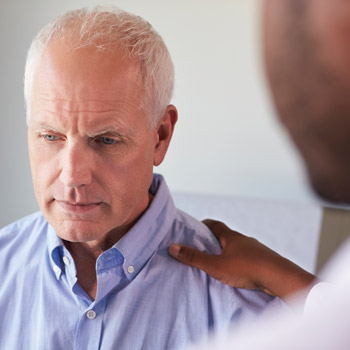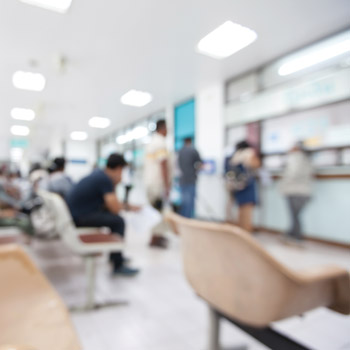Conversing about cancer at ASCO conference
Physician-patient communication has been tied to important outcomes, including quality of life, and a variety of strategies to improve communication exist.
Although experts from around the world gathered at the annual meeting of the American Society of Clinical Oncology specifically to talk about cancer, a theme of their discussions was how difficult, and rare, such conversations are in practice.
“When oncologists have been recorded in the exam room, they miss about two-thirds of the empathic opportunities. The patient says, for example, ‘I'm worried about my disease and I'm scared,’ and a lot of times our response is something cognitive, about the scan or about the treatment,” said Thomas LeBlanc, MD, an oncologist and associate professor at Duke University in Durham, N.C.

Although there's a natural tendency to focus on the more clinical aspects of cancer care, physician-patient communication needs improvement and attention, the experts agreed. Talking about patient-reported outcomes and psychosocial distress has been tied to important outcomes, including quality of life. The evidence of these associations and a variety of strategies to improve communication were offered during several sessions at the conference, which was held in Chicago in June.
“The purpose is to make sure that people get the cancer care that they deserve,” said Donald Rosenstein, MD, a psychiatrist and professor at the University of North Carolina (UNC) in Chapel Hill, speaking about distress screening. “Fundamentally ask people, ‘Who are you, what's important to you, and how can we make things better?’”
Patient-reported outcomes
Measuring patient-reported outcomes (PROs) has long been a component of pharmaceutical research, explained Ethan Basch, MD, MSc, a medical oncologist and health services researcher at UNC. “Historically they have not been used as much in routine care for monitoring patients' status, but there's been rapidly growing interest in this area,” he said.
PROs include any outcome of medical care that is reported directly by a patient or caregiver; commonly measured ones in oncology include pain, fatigue, nausea, and depression. But PROs are useful and used in other medical specialties, too.
Carolyn Kerrigan, MD, another speaker in the session “Patient-Reported Outcomes: Expanding from Plenary to Everyday Practice” and a professor of surgery at Dartmouth College in Hanover, N.H., described how PROs came to Dartmouth-Hitchcock Medical Center.
“It was our spine center that launched first, and our pain center soon behind,” she said. “One thing that they use clinically a lot is patient diagrams—having the ability for patients to draw where their symptoms are is crucial to some specialties.”
Obviously, this information can be used to guide individual patients' care, but there are additional purposes as well, including measuring the effectiveness and safety of specific treatments or the quality of care at a facility, Dr. Basch explained.
“This information can also be aggregated and shared with future patients who are facing decisions and wish to know how patients like them experience the treatment that they're considering,” he said.
To facilitate these uses, it's helpful to have PRO measurements incorporated into the electronic health record, and many are, but they can also be gathered in other ways, even on paper. The speakers described a variety of collection methods, from patient portals accessible before visits to tablets and kiosks in the waiting room to oral interviews in the exam room.
The benefits of implementing these systems are supported by research, Dr. Basch reported. “The mounting evidence shows that PROs significantly improve patient satisfaction, communication with providers. They improve clinician awareness of patient issues,” he said. “Multiple clinical outcomes are improved, and utilization of emergency room and hospital services are often decreased when patients are engaged to communicate their symptoms using such a system with their providers.”
An example from England, called eRAPID, showed how such results can potentially be achieved. Cancer patients participating in a pilot at the University of Leeds were asked to routinely log in and rate themselves on 12 to 15 common symptoms. Their answers to questions like “Have you felt sick (nauseous or queasy)?” are graded by severity, and then responded to automatically.
“If they report a severe symptom, there is an immediate alert that tells them who to contact,” said Galina Velikova, MD, PhD, professor of psychosocial and medical oncology at the University of Leeds. “If they have mild symptoms, they will get just self-management advice.” Patients whose results fall somewhere between will get advice about seeking help less urgently.
The initial trial of 87 patients found that only about 2% received the most severe alerts. “Around two-thirds got self-management advice for mild symptoms only, so I think this kind of answers the concern of some clinicians that they might be overwhelmed by alerts. That's not the case,” said Dr. Velikova.
Both patients and clinicians gave the system positive reviews. “Patients value the directions on when to contact the hospital. They didn't want to unnecessarily call the hospital, and also receiving reassuring advice that it's normal to feel like that and you can do simple things was very valuable as well,” Dr. Velikova said.
That repertoire of simple things to do in response is an important component of a PRO program, noted Lisa Barbera, MD, associate professor in the department of radiation oncology at the University of Toronto in Canada.
When the province of Ontario started collecting PROs, “There was a lot of effort that was put into building symptom management guides, both for patients and for providers,” she said. “One of the pushbacks that we got in the initial implementation was ‘What am I supposed to do with this score, and how do you expect me to respond?’”
Clinicians can now respond with handouts specific to the problem reported by the patient, such as fatigue, and if needed, get resources to help guide treatment.
“The clinician-facing guidance is primarily aimed at nursing and allied health. The feeling was that physicians would be managing the more severe symptoms and drawing on their medical expertise and guidelines,” Dr. Barbera said. “This was to try to help foster some of that teamwork and team approach to the management of the symptoms.”
To see the benefits of collecting PROs, it's critical that some member of the health care team review every patient's report of symptoms with him or her, the experts noted. “You're not going to order an X-ray and then not discuss the results with patients. It should be the same approach with patient-reported outcomes,” said Dr. Kerrigan.
Distress screening
The importance of how one responds to a patient's reported problems was also a focus of the session “Psychosocial Needs of Cancer Survivors and Best Practices for Distress Screening.”
“It probably matters less which specific [distress screening] tool you use than what you do with the information once you get it,” said Dr. Rosenstein. But before offering action steps, he began with a definition of the symptom being measured: “Psychosocial distress is a multifactorial unpleasant experience of a psychological, social, spiritual, and/or a physical nature that may interfere with the ability to cope effectively with cancer, its physical symptoms, and its treatment.”
That specifically does not include the many psychological issues that may have distressed patients over the course of their lives.
“I'm a psychiatrist by training and we see a lot of patients with medical/surgical problems who have comorbid psychiatric problems, and we have a central mantra. The mantra is that we are in the business of making sure, if we can, that people receive the medical care that they are in the hospital for. It's not the time to try and repair things that went wrong early in life,” he said. “It may not even be the right time to finally get off that last little dose of that benzodiazepine.”
Distress screening is closely related to PRO measurement, the experts said. It carries some of the same benefits, uses similar screening methods and technologies, and should be responded to with existing resources based on symptoms as well as personalized interactions.
However, handling a patient report of distress can be more complicated than one of nausea, for example. “When someone scores high on any kind of distress screen, you don't really know” whether the specific problem is that the patient has insomnia, is worried about finances or sexual function, or is “just enraged because it took them a while to find a parking spot or they had to pay for parking and they didn't expect to,” said Dr. Rosenstein.
With so many potential causes, positive results on distress screens are common. “Depending on which tools are used and when they're administered and so on, and which patient populations, you can have roughly 30% to 40% of all cancer patients who endorse significant psychosocial distress,” said Dr. Rosenstein, who noted debate among experts about the best timing and method for distress screening.
Although it seems natural to treat all identified problems, that won't always be needed or wanted. “This is the triage moment,” Dr. Rosenstein said. “You ask someone, ‘You've shared this information with us, would you like some help with this?’ You'd be surprised how many people say, ‘Actually not right now, thanks for asking.’ Or, ‘Under no circumstances will I ever want to be sent to see a psychiatrist.’”
Patient preferences should guide the response to distress screening, agreed Carole Mayer, PhD, director of research for the Supportive Care Oncology Research Unit at the Northeast Cancer Centre in Sudbury, Ontario.
“Where you may want to start as the most distressing symptom may not be where the patient wants to start. We encourage a conversation to ask the patient what's important for them,” she said.
Patients who don't want immediate treatment of their distress should be offered opportunities to seek it later as needed, she added. “If a patient is offered a referral to a psychosocial specialist and declines, we really encourage the teams to give them the information. Perhaps the patient needs to think about it and have resources they can call once they leave the clinic.”
Obviously, for patients who do want treatment, resources should be ready. “When we implemented distress screening programs in community oncology clinics, some nurses were reluctant to engage because they were concerned that they didn't know what to do with depression, they didn't know what to do with anxiety. We provided education on the various roles of supportive care and psychosocial oncology disciplines and created referral pathways in the community with linkages to the cancer center using telemedicine. Much effort was placed on evidence-based guidelines to address depression and/or anxiety to support the nurses' clinical practices to talk with patients about their symptoms,” said Dr. Mayer.
Clinicians may be surprised by how much help is available, whether the cause of a patient's distress is insomnia or worry about money, according to Mathew J. Loscalzo, MSW, executive director of the department of supportive care medicine at City of Hope in Duarte, Calif. “Most places who do not feel they have the resources have not done a resource inventory, and one should do one,” he said.
The final speaker in the session described a newly available resource for distressed cancer survivors, especially those with post-traumatic stress disorder (PTSD). “When we look at survivors of adult cancer, the prevalence of full PTSD is about 10%. However, when you look at significant impact to quality of life … between 20% and 80%, depending on the various populations,” said Sophia Smith, PhD, MSW, associate professor at Duke University School of Nursing in Durham, N.C.
PTSD may present as nightmares, difficulty concentrating, or avoidance of care, among other symptoms. “Survivors may really resist going back to their place of treatment for follow-up care, just because of the reminders of what they went through,” Dr. Smith said.
To treat these forms of distress, she and her colleagues modified an app built for veterans and tested it with cancer survivors. “What we found really blew us away. About half of the sample had significant reductions in PTSD symptoms after only four weeks of app usage,” she said. The app, called Cancer Distress Coach, is available free for iPhones and Android devices.
“It plots their distress over time so they'd be able to share that with their health care provider,” Dr. Smith said. “We have stress management tools, deep breathing exercises, relaxation, guided imagery. One of the favorites is the soothing pictures and music—our patients really, really love that one.”
The ease of access to the app could help overcome the barriers to treatment of distress, she said, noting that the current response to a positive screen often ends with a referral. “Then we kind of cross our fingers. Are they really going to get to where they need to be? A lot of times it doesn't happen.”





